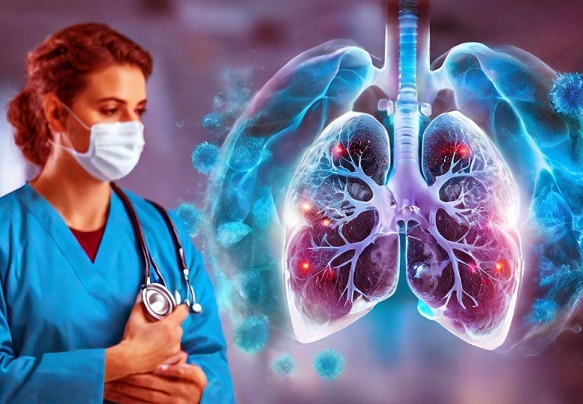Nikhil Prasad Fact checked by:Thailand Medical News Team Feb 04, 2025 2 months, 1 week, 6 days, 16 hours, 18 minutes ago
Medical News: A team of researchers from Justus Liebig University Giessen-Germany, Ludwig-Maximilians University Munich-Germany, Duke University School of Medicine-USA, Wenzhou Medical University-China, Heidelberg University Hospital-Germany, and the German Center for Lung Research has made a breakthrough discovery in understanding lung regeneration following injury induced by Influenza infection. Their findings provide critical insights into how certain cells contribute to lung healing and why their dysfunction can lead to severe respiratory diseases.
 New Insights into Alveolar Regeneration in Influenza-Induced Lung Injury
New Insights into Alveolar Regeneration in Influenza-Induced Lung Injury
Lung injuries caused by infections like influenza or chronic conditions such as chronic obstructive pulmonary disease (COPD) often result in impaired healing and fibrosis. This
Medical News report highlights how researchers have identified a specialized group of cells, called AMF-like cells, that play a vital role in alveolar regeneration. These cells share characteristics with alveolar myofibroblasts (AMFs), which are crucial during lung development but were previously not well understood in adult lung repair.
Key Findings of the Study
The study utilized advanced single-cell transcriptomic analysis to track how lung mesenchymal cells behave during development and in response to injury. The researchers found that AMF-like cells become activated in response to influenza virus-induced lung damage. These cells exhibit similar characteristics to AMFs seen during early lung development, suggesting that the body reactivates developmental programs to aid in tissue repair.
One of the most important discoveries was that AMF-like cells do not originate from fibroblast growth factor 10 (FGF10)-positive alveolar fibroblasts, which are often associated with normal lung repair. Instead, their activity appears to be independent of this pathway, marking a significant departure from previously understood lung healing mechanisms. The study also showed that when AMF-like cells become dysfunctional, lung repair fails, leading to conditions such as fibrosis and respiratory distress syndrome.
Implications for Lung Disease Treatment
The research team conducted further analyses on human lung samples from COPD patients and individuals who suffered from severe acute respiratory distress syndrome (ARDS). They found that in COPD lungs, the expression of key regenerative markers such as CTHRC1 and GLI1 was significantly reduced. This suggests that the lack of functional AMF-like cells contributes to the progressive lung deterioration seen in these patients.
In contrast, lung tissues from patients with ARDS showed excessive activation of AMF-like cells, particularly in areas with severe tissue remodeling. This abnormal response may be responsible for the formation of scar tissue rather than effective regeneration, ultimately leading to non-resolving fibrosis and poor patient outcomes.
Potential for Future Treatments
These findings open new possibilities for therapeutic strategies aim
ed at enhancing lung regeneration. By targeting AMF-like cells and their signaling pathways, researchers hope to develop treatments that can either promote lung healing in COPD patients or prevent excessive fibrosis in ARDS cases. One potential avenue is the regulation of GLI1 and CTHRC1, which could be manipulated to optimize the regenerative properties of mesenchymal cells.
Additionally, understanding the precise interactions between AMF-like cells and epithelial stem cells could lead to innovative stem cell therapies or pharmacological interventions that encourage proper lung repair. The study underscores the need for further research to refine these approaches and test potential treatments in clinical settings.
Conclusions
This study sheds light on the crucial role of AMF-like cells in lung regeneration and disease progression. The researchers demonstrated that these cells are essential for alveolar repair, but their dysfunction can either hinder regeneration or promote fibrosis, depending on the disease context. The discovery that AMF-like cells are distinct from traditional fibroblasts challenges existing views on lung healing and offers new targets for future treatments.
The implications of this research are significant, especially for patients suffering from chronic lung diseases or severe respiratory infections. By harnessing the regenerative potential of AMF-like cells, scientists may pave the way for groundbreaking therapies that could improve lung health and patient survival rates.
The study findings were published in the peer-reviewed journal: Cell Reports.
https://www.sciencedirect.com/science/article/pii/S2211124725000191
For the latest Influenza News, keep on logging to Thailand
Medical News.
Read Also:
https://www.thailandmedical.news/news/new-zealand-study-unveils-role-of-human-cellular-proteins-hdac1-and-hdac2-in-combating-influenza-a-virus
https://www.thailandmedical.news/news/rtp4-role-in-stopping-influenza-spread
https://www.thailandmedical.news/news/new-approach-using-traditional-japanese-medicine-and-minocycline-for-influenza-treatment
https://www.thailandmedical.news/articles/influenza-or-flu
